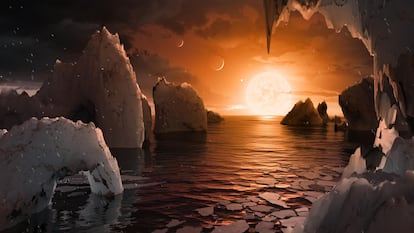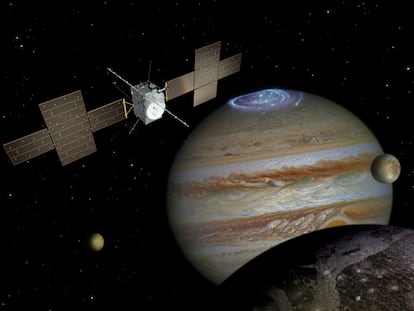The ‘terminator’ zones of exoplanets: New ways to search for extraterrestrial life
A study suggests researchers should not overlook planets lying close to M dwarfs that could have a habitable area between a ‘scorching dayside and a glacial nightside’

The search for life beyond Earth has long since ceased to be a wacky pseudoscientific quest to become a fascinating scientific adventure. But that adventure moves very slowly. First, extrasolar planets began to be detected, of which more than 5,000 have already been located. After that, it was necessary to determine which of them held the possibility of harboring life. And this created one of the biggest stumbling blocks. “The problem,” says Ester Lázaro, a researcher at Spain’s Astrobiology Center, “is that we have used very little imagination, and up to now we have only been considering planets similar to Earth.”
But a study recently published in The Astrophysical Journal proposes new candidates, planets that are very different from our Earth but that “we must study to increase our chances of identifying habitable planets,” according to Ana Lobo, from the University of California at Irvine and lead author of the paper. The planets that Lobo has investigated are very peculiar and orbit around the so-called M dwarf stars, or red dwarfs. “These stars are the most common and account for 70% of all stars in the galaxy,” explains the lead researcher.
Compared to our Sun, M dwarfs are “low-mass stars, with a mass between one-tenth and 60% of the mass of the Sun. They are small and cooler, but they are very abundant, both in our neighborhood and in the rest of the galaxy”, says Cristina Rodríguez López, a researcher at the Institute of Astrophysics of Andalusia. The abundance and characteristics of these stars, which make it easier to locate planets around them, have made them the most investigated suns in the search for extrasolar planets capable of hosting life. However, it is not very common to find Earth-like planets around these stars.
As they are dimmer (that is, with temperatures much lower than our Sun), their so-called habitable zone, in which planets whose temperatures allow the existence of liquid water are supposed to be, is much closer to the star than in our solar system. For this reason, in a large part of that habitable zone, the proximity of the star causes the synchronous rotation of the planets with their star, similar to what happens between the Earth and the Moon. And as happens with our satellite, the result is that these planets always have a light side and a dark side.
“When you think of planets with a burning face, over 1,000ºC, and another icy one, at less than -100ºC, they are immediately ruled out as likely to harbor life,” says Esther Lázaro. “The interesting thing about this new research is that it proposes a scenario that could make the existence of life possible in them. It doesn’t prove that it is so, but it opens up a lot of possibilities for the future.”
The key in the new research are so-called “terminator” zones. Just as the equator is a strip between the northern and southern hemispheres of the Earth, the terminator zone is the strip that separates the permanent day side from the permanent night side on these planets. The paper analyzed what that strip might be like on planets that have a limited amount of water, that is, planets that are not totally covered by oceans — the only ones being considered until now. “If these planets have limited amounts of water, the terminator zone can remain at moderate temperatures favorable for habitability,” says Lobo.
This work introduces a variable that can be decisive when programming future research in the search for extraterrestrial life, as Lobo explains: “Very often we affirm the habitability of a certain exoplanet as a simple yes or no answer. But Earth has a wide range of climates, and extrasolar planets may have even greater diversity. It is possible that habitable worlds are not necessarily habitable over their entire surface, but could have regions that are and others that are not.”
Rodríguez López, who has not participated in the research, explains the importance of this work: “What it does is open up new possibilities and, furthermore, it does so at a very important moment because, from now on, newly discovered exoplanets will start getting characterized, and this work will be done by the James Webb Space Telescope. That is why groups around the world are proposing favorable planets for the telescope to observe. What the paper in The Astrophysical Journal does is say: ‘hey, these other worlds can be interesting too.’ It is a wake-up call about what was being discarded.”
Of course, nobody should think of little green men or women with antennas, Lázaro says. “If there is life in those terminator zones, it is most likely microscopic life because it seems very difficult for complex life to develop in such a limited space as those regions must be. But even if we were talking about microscopic life, it would still be life.”
Sign up for our weekly newsletter to get more English-language news coverage from EL PAÍS USA Edition
Tu suscripción se está usando en otro dispositivo
¿Quieres añadir otro usuario a tu suscripción?
Si continúas leyendo en este dispositivo, no se podrá leer en el otro.
FlechaTu suscripción se está usando en otro dispositivo y solo puedes acceder a EL PAÍS desde un dispositivo a la vez.
Si quieres compartir tu cuenta, cambia tu suscripción a la modalidad Premium, así podrás añadir otro usuario. Cada uno accederá con su propia cuenta de email, lo que os permitirá personalizar vuestra experiencia en EL PAÍS.
¿Tienes una suscripción de empresa? Accede aquí para contratar más cuentas.
En el caso de no saber quién está usando tu cuenta, te recomendamos cambiar tu contraseña aquí.
Si decides continuar compartiendo tu cuenta, este mensaje se mostrará en tu dispositivo y en el de la otra persona que está usando tu cuenta de forma indefinida, afectando a tu experiencia de lectura. Puedes consultar aquí los términos y condiciones de la suscripción digital.
More information
Últimas noticias
Russell Tovey: ‘I was advised many times not to come out, I don’t think there was many people who’d done that — and I feel really proud that I’m one of those that did’
Patagonia’s puma population soars thanks to unexpected prey: penguins
Merz tries to replace Macron at the helm of Europe
Indulgence, punishment and family dynamics: Maintaining a healthy relationship with food during the holiday season
Most viewed
- The low-cost creative revolution: How technology is making art accessible to everyone
- Families demand repatriation of bodies of Colombians who died in Ukraine: ‘This war is a slaughterhouse for foreigners’
- Christian Louboutin: ‘Young people don’t want to be like their parents. And if their parents wear sneakers, they’re going to look for something else’
- US sanctions against jailed cartel leader ‘El Marro’ highlight Mexico’s lack of control over its prisons
- Liset Menéndez de la Prida, neuroscientist: ‘It’s not normal to constantly seek pleasure; it’s important to be bored, to be calm’











































